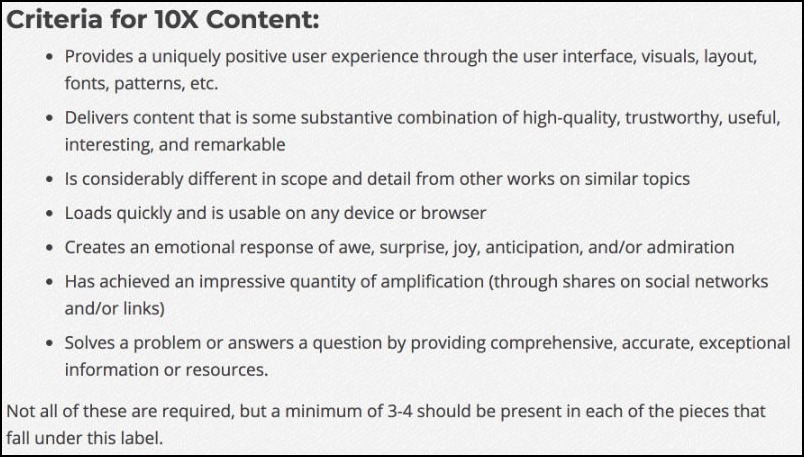Marketers (myself included) love to talk about how important it is to create “quality content.” But what does “quality content” really mean?
Social Media Manager, Teajai Kimsey, describes quality content as this:
“Content in any form (video, images, text) that resonates with your target audience causing engagement beyond a simple like.”
Teajai’s point about engagement is worth repeating. Engagement is crucial for quality content. If your content isn’t getting engagement, it probably isn’t quality. This raises one question: how do you know if your content is good enough to get engagement before you publish it?
In another blog post, I wrote that quality content is informational, educational, and/or entertaining. That’s 100% true, at a high level. But, it still doesn’t help you figure out how to create quality content.
So let’s break down low quality and high quality content to help you figure out exactly what you need to do to create high quality content.
But First, Low-Quality Content
I’ll start by explaining what low-quality content is in Google’s eyes. Google has actual humans, called Quality Raters, who audit search results to make sure that Google is serving up quality content.
According to the guidelines used by Quality Raters, a page should be rated as low quality if one or more of the following applies:
- An inadequate level of expertise. Example – you’re writing about tax preparation, and have no expertise in the area.
- The quality of the main content is low. Example – It’s obvious that you wrote a page about tax preparation without doing any research.
- There is an unsatisfying amount of content for the purpose of the page. Example – you’re writing about the history of the US Tax Code and boil it down to 3 paragraphs.
- The title of the page is exaggerated or shocking.
- There are ads that are distracting. Google is specifically talking about pop-ups here. You’ll be okay if your pop-up is easy to close.
- There isn’t enough information to find out more about the creator of the content. If someone has to do extensive research to figure out who the author of the page is, that’s a problem in Google’s eyes.
- A mildly negative reputation for the website or creator.
That mostly vague explanation is what Google calls low-quality content. I want to focus on one point, though. One that marketers really misconstrue.
Marketers Really Miss the Mark
The third point, Google writes, “There is an unsatisfying amount of content for the purpose of the page.” Many marketers have honed in on that point and determined that Google must mean that quality content is extremely lengthy.
We’ve probably all read that quality content must be 2,000 words or more, right?
I actually think that’s very wrong, and mostly due to confirmation bias. Marketers had this idea that lengthy content = quality content. Then, when someone did some research, they found that the top ranking and shared articles are all over 2,000 words. But, and this is a huge “but,” the data is actually skewed in most of those studies.
Take it from the Director of Buzzsumo, Steve Rayson, in a comment he left on a blog post:
“The average shares for long-form content are only higher because there is so much poor quality short-form content, and this drags the average for short-form content down. Inherently long form is not better, in fact many of us prefer the author to take time to make content shorter. I did an analysis of the posts of the top 100 Mar/Tech blogs and 81 of the 100 most shared posts had less than 1,000 words.“
If that’s not enough to convince you that word count doesn’t matter, take a look at Twitter, LinkedIn, and Instagram. Posts on those platforms are almost all very short, in terms of word count. But, people share, retweet, and favorite those short posts. Does the fact that a post is only 200 characters mean it’s low quality? I’m saying, “No!”
Or consider Seth Godin’s blog. Most marketers would say that his blog is a leader in the marketing space. All of his posts are short, though. Really short. Some are less than 100 words.
I’ve got one more example. How about the website IFLScience? Most of their content is exceptionally short and performs very well. Take this post for example:
That post has almost 500,000 shares, 179 backlinks, but is only 244 words. And before you claim, “that’s not quality content!” Let me ask, “why not?” It’s entertaining, and there is absolutely nothing wrong with creating content for pure entertainment. Ask The Onion, if you don’t believe me.
Don’t get me wrong, there is a time and a place for long-form content. That’s why this piece is 1,636 words. Take as many, or as few, words as you need to prove the point you’re setting out to prove.
Moving on From Word Count…
I realize that I still haven’t answered the question that I set out to answer. Let’s jump back to Google for a second. They do have guidelines for high-quality content. The Goog’ boils high-quality content down to four points:
- Make pages for users, not search engines.
- Don’t deceive your users.
- Avoid tricks intended to improve search rankings (don’t do black hat SEO).
- Think about what makes your website unique, valuable, or engaging. Make your website stand out from others in your field.
If you thought the low-quality guidelines were vague, I’d say the high-quality guidelines are even more vague.
I’m going to lean on Rand Fishkin for a better explanation of high-quality content:

In case you’re not familiar with 10X Content, it’s simply content that is 10 times better than anything else out there on the topic. You could call it “extremely high-quality content.” Rand’s explanation is a great summary of high quality content.
Let’s examine a few examples of high-quality content.
The Definitive Guide To SEO In 2018 by Backlinko
Here’s a good example of a piece of high-quality content being exceptionally lengthy. This could be an entire book.
I’ll put this to the test against Rand Fishkin’s guidelines:
- Does it provide a positive user experience? Yes. It’s beautifully designed and simple to navigate with the table of contents. On top of that, Backlinko uses headings, images, and videos to break up the text.
- Does it deliver content that is useful, interesting, and remarkable? Heck yes.
- Is it considerably different in scope and detail from other works on similar topics? Yes, it’s probably the most in-depth piece of content on SEO in 2018 that I’ve come across.
- Does it load quickly on multiple devices? Nope. It’s truly slow. So this point is a miss.
- Does it create an emotional response? Yes, I definitely admire this piece of work.
- Has it achieved an impressive quantity of amplification on social networks? With 10,875 shares, I’d say yes.
- Does it solve a problem or answer a question? Sure does, and Backlinko provides examples and research to prove the points.
How about one more for good measure? This one is very different because it’s not a lengthy blog post. It’s a tool.
Website Grader by Hubspot
This tool gives you a grade of your website based on performance, SEO, and security. I’ll use Rand’s framework again:
- Does it provide a positive user experience? Absolutely. It’s simple to use and learn from.
- Does it deliver content that is useful, interesting, and remarkable? Yep, it gives useful information about a website that you can put into action.
- Is it considerably different in scope and detail from other works on similar topics? I’d say so. I don’t know of any other free tools that are as helpful at this one.
- Does it load quickly on multiple devices? Yep, Pingdom gives it a “B” as a performance grade.
- Does it create an emotional response? Yes, I’m surprised by the usefulness of this tool.
- Has it achieved an impressive quantity of backlinks? Sure has. It has almost 400,000 of ’em.
- Does it solve a problem or answer a question? Yes. It helps analyze your website performance problems.
But wait, there’s more! I have one last example…
What’s Really Warming the World? by Bloomberg
This report from Bloomberg shows a visual representation of the factors that might be leading to global warming. It’s really interesting so let’s see if it stands up to Rand’s standards:
- Does it provide a positive user experience? Yup, It’s dead simple to understand.
- Does it deliver content that is useful, interesting, and remarkable? Yes. The simplicity of it makes the data easy to understand and remember.
- Is it considerably different in scope and detail from other works on similar topics? Absolutely. I didn’t find anything else quite like this.
- Does it load quickly on multiple devices? Sort of, Pingdom gives it a “C,” which isn’t great. But not terrible.
- Does it create an emotional response? Yes, 100% yes.
- Has it achieved an impressive quantity of backlinks? Sure has. It has almost 8,300 of ’em.
- Does it solve a problem or answer a question? No doubt about it.
Wrapping It All Up
I asked our Facebook group members to define quality content, and I got some great responses. Take this one from Suzannah Van Rooy, the Founder of Digital Sparrow:
“Quality content is content that can be put into action, adds to educational value to my day, or moves me emotionally. I never want to waste my time with what I am consuming.”
Suzannah wrote three important words there — actionable, educational, and emotional. If your content hits at least one of those, it has a chance of being a quality piece.
One more quick note: if you’re setting out to create high-quality content, you have to be ready to invest time and money into it. You might even need to hire someone to help you create your piece of high-quality content — a writer, designer, or developer.
So let me ask you, is this piece high-quality? Feel free to let me know on Twitter.







